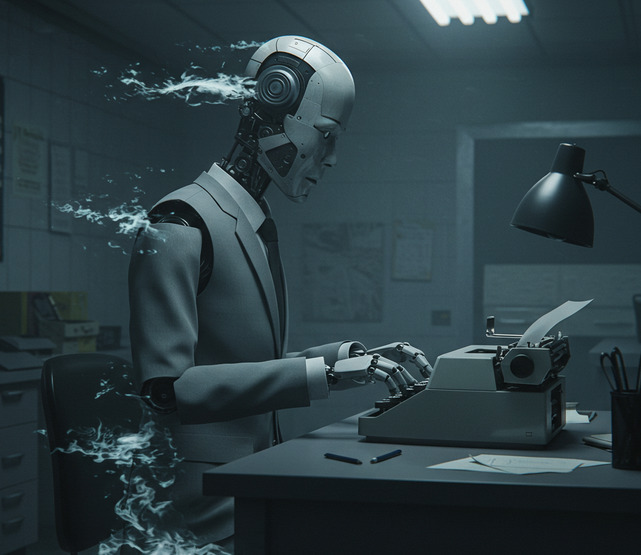GHOST EMPLOYEES
(INOD), (NVDA), (IBM)
A few months ago, I found myself trading shots of sake with the CTO of Japan's largest AI firm at 2 AM in a Tokyo back-alley izakaya – the kind of place where salarymen go to forget debugging nightmares.
After his fourth drink, he leaned in conspiratorially.
"You know what's funny?" he slurred, loosening his tie. "We just spent $20 million on Nvidia (NVDA) hardware, but our biggest expense isn't computing power – it's paying humans to teach our AI systems how to think." He tapped his temple knowingly.
"Everyone's obsessed with GPUs, but the real bottleneck is quality training data." I nearly choked on my yellowtail sashimi.
Here was one of Asia's most prominent tech executives confirming what I've suspected since watching IBM's (IBM) Deep Blue defeat Kasparov back in '97: the emperor's AI clothes aren't quite as autonomous as advertised.
The dirty little secret of artificial intelligence isn't very artificial at all.
Behind every "intelligent" system lurks an army of humans doing the intellectual piecework that machines still can't handle.
What most investors missed then (and still miss today): IBM spent thousands of hours having humans hand-code chess positions to make the machine appear "intelligent."
Nearly three decades later, the AI industry's dependence on human labor remains its least discussed vulnerability – and its most interesting investment opportunity.
Enter Innodata (INOD), a company that's quietly climbed 580% this year while everyone was fixated on Nvidia's trillion-dollar hardware empire.
INOD isn't building the next chatbot or revolutionary language model – they're providing the human foundation that makes those systems possible.
When ChatGPT reads "The sun is shining" and interprets this as a positive statement, it's because humans tagged thousands of similar phrases and taught the system to recognize their emotional tone.
This is the unglamorous reality of AI that no one at Silicon Valley cocktail parties wants to discuss.
I've been following INOD since they were a struggling document processing company trying to reinvent themselves.
Founded in 1988, they've transformed from a business outsourcing provider into what might be the most essential ingredient in AI development – the human intelligence that teaches machines how to think.
With 6,597 employees across 31 countries, they've infiltrated the supply chains of several "Magnificent 7" tech giants who publicly boast about their AI capabilities while privately depending on INOD's human workforce.
The financials tell a compelling story that most investors are missing. INOD delivered 100% year-over-year revenue growth, reaching $170 million in annual sales.
More importantly, they've transformed consistent losses into $28.66M in profit – a transition I've rarely seen executed so efficiently in the tech sector. Operating margins have improved from 14% to an estimated 21% by 2026, with Wall Street projecting 42% revenue growth in 2025.
Most AI investments suffer from what I call "someday syndrome" – a condition I diagnosed after sitting through hundreds of tech pitches featuring eye-watering valuations, massive cash burn rates, and vague promises about future profits.
INOD flips this script by generating actual earnings while providing a service the industry desperately needs right now.
Unlike many AI companies burning cash faster than a pyromaniac at a match factory, INOD operates debt-free – a quality I've come to appreciate after watching promising tech companies implode when funding markets tightened.
The bull case for INOD boils down to one premise I've observed repeatedly in my four decades of tech investing: the road to AI autonomy is much longer than optimists believe.
Just last week, I spent 15 minutes at a self-checkout trying to convince the machine I had placed my items in the bagging area. The system kept insisting I hadn't – a minor but telling example of AI's limitations when confronting the messy realities of the physical world.
What makes INOD particularly valuable is their expertise in specialized domains. They employ doctors who annotate medical imagery, lawyers who tag legal documents, and financial experts who label market data – creating custom training sets for specialized AI applications that general models struggle with.
As every industry develops its own specialized AI models, the demand for domain-specific training data grows exponentially.
Of course, I've been spectacularly wrong about technology timing before. In 1999, I bet heavily on early e-commerce platforms, only to watch most of them collapse when the infrastructure wasn't ready.
The bears have legitimate concerns about INOD: advances in self-supervised learning could reduce dependence on human annotation, real scalability challenges exist (they spent $3.6 million on recruiting for just one client in Q2), and a PE ratio of 55x isn't exactly what I'd call a value play.
The investment thesis ultimately comes down to timing – how long will AI need intensive human intervention?
If you believe, as I do after watching this space evolve since the early neural network days, that we're years away from fully self-sufficient AI, then INOD's current valuation might represent reasonable value.
By 2026, we're looking at a forward PE of 27x – quite reasonable for 20%+ annual growth in the AI sector.
For those with high risk tolerance and a 2-3 year horizon, INOD offers AI exposure without betting on which model architecture will dominate. They're selling picks and shovels in a gold rush, but their tools are human minds rather than silicon chips.
Don't expect a smooth ride – the stock has already soared, and the tension in their business model guarantees volatility.
While flying back from that Tokyo conference, I couldn't help but appreciate the irony: INOD is helping build systems that could eventually automate their own operations. They're training their replacements.
But having watched technology evolve over five decades, I've learned that disruption rarely follows a straight line. The human-powered company might just be the perfect AI stock for those who recognize that machines aren't ready to bootstrap themselves into superintelligence.
That, or I've just written words that an INOD contractor will eventually annotate to train the model that puts financial analysts out of work. After climbing Everest and flying a MiG-25 at the edge of space, being replaced by an algorithm I helped train would be a fitting final adventure.


